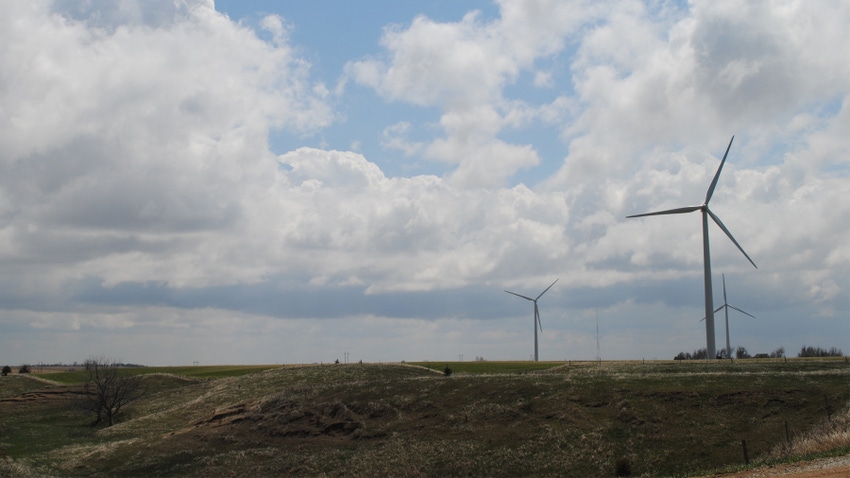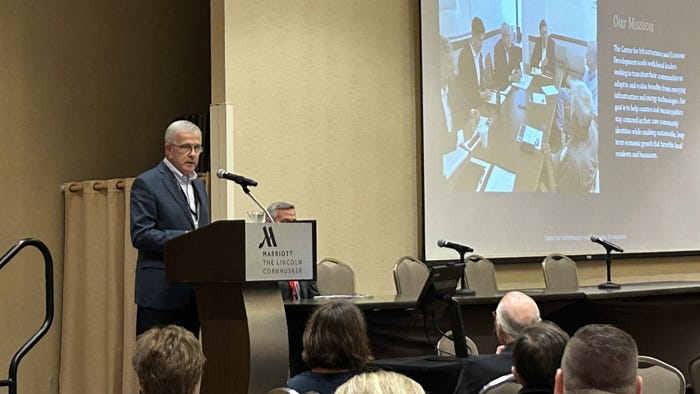
Renewable energy is not a new concept, especially in the agricultural industry. With the push for renewable energy across the country, including on the farm and ranch, there have been passionate and well-researched arguments on both sides of the wind energy issue.
At the 2023 Nebraska Wind and Solar Conference held in October in Lincoln, attendees heard about the opportunities in the wind energy space, along with different issues that are arising while installing scores of wind turbines in the rural landscape.
“Renewable energy projects can be a real help to farmers and ranchers. They can help keep their farm and ranch viable and provide more predictable income streams,” said Mike Johanns, former Nebraska governor, U.S. senator and secretary of agriculture in the George W. Bush administration.
Johanns, now national co-chair for the Center for Infrastructure and Economic Development, spoke about the opportunities for agriculturalists in the wind energy sector, along with some of the obstacles that still need to be overcome.
Farmer and community vitality
“The 2023 forecasts from the USDA showed that the net farm income declined by 23%, which means that our farmers will be squeezed when it comes to profits,” Johanns said.
If a farmer or rancher is in this situation — where cash flow is a big obstacle to overcome — wind energy projects could be a viable option to keep them in business, he said. While many producers might have hesitations about these projects, it is important to look at their operation and the possibilities that wind energy can provide, Johanns explained.
Aside from the fact that farmers can have a more reliable source of income because of these renewable energy projects, they also can bring more revenue to their communities. Farmers and ranchers that lease their land for these projects inadvertently add new tax revenue to local governments.
“In 2022, renewable energy projects alone paid about $17.3 million in property, state and local taxes in Nebraska,” Johanns said.

CAPTURING WIND ENERGY: Mike Johanns, former Nebraska governor, U.S. senator and secretary of agriculture, spoke to conference attendees about the different ways that wind energy projects can bring economic success to communities, as well as dealing with some of the concerns around wind energy projects.
In Holt and Antelope counties, for instance, the Grand Prairie Wind Project fostered substantial economic development. This includes contributing $2.6 million in taxes to the counties each year, with an additional $3.87 million in taxes for public school improvements, he noted.
These respective counties were able to gain new classrooms, including rooms for special-needs students, a new music room and a new science classroom in their school districts. This allowed the school to stop busing students off campus because of the lack of facilities.
But Johanns reiterated, the benefits of wind energy are not all monetary. “Solar and wind operations function as a conservation strategy,” he said.
He compared the conservation benefits of letting the land rest to projects such as crop rotation or conservation initiatives. This is one way that farmers and ranchers can ensure the land is available for future generations to come, he said.
Concerns of turbines
While there are several beneficial opportunities to arise because of wind turbines, there are also major downsides that cause producers to drag their feet when thinking about signing a wind energy contract, Johanns acknowledged.
Three issues that farmers and ranchers raise with wind projects include lower yields because of downtime in the field, the issue of decommissioning the wind towers when their usefulness has passed, and changes in the rural landscape of the countryside.
Even though the land will be given rest during this downtime, it keeps the farmers out of the field, reducing yields in the short term, Johanns said. During construction of wind towers, it can be more difficult to plant and harvest the fields to their full potential on that land.
Once the wind towers need to be decommissioned, the biggest question is, “Where do they go?” he said. Primarily made of steel, fiber glass and plastic, wind turbines are not biodegradable. In addition, the flashing lights at night across the countryside can take away from the natural scenery.
“We know that integrating wind and solar into a community has to be accomplished with a balanced policy,” Johanns said. “We need to work together to make sure everyone’s needs are met.”
Making sure that both parties are satisfied with the new projects is a necessity to bring more turbines to these rural communities.
“There are balanced and practical solutions that can help us all get to a ‘yes,’” Johanns added.
To learn more about the Center for Infrastructure and Economic Development, visit centerforlocalpolicy.org.
Wind facts for Nebraska
Current wind energy capacity (2022): 3,500 megawatts
Number of wind turbines in the state: 1,500
Number of utility scale wind farms (2022): 34
First wind turbines in Nebraska: Springview, 1998
Source: Nebraska Department of Environment and Energy; U.S. Energy Information Administration
About the Author(s)
You May Also Like






